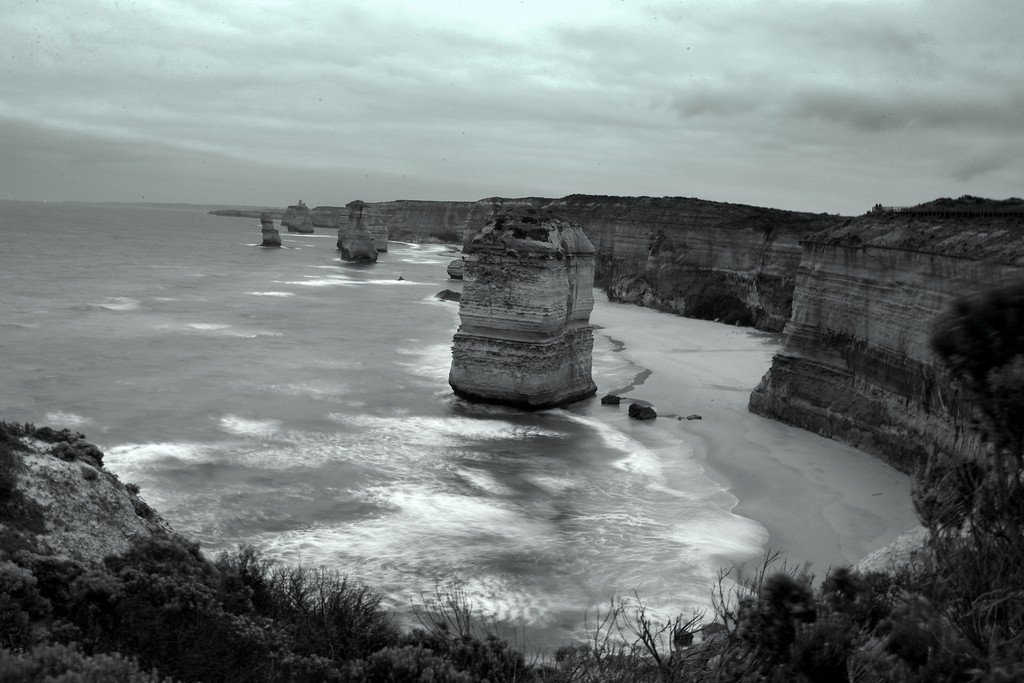THE TWELVE APOSTLES
The Twelve Apostles («les douze apôtres» en français) désigne un regroupement d'aiguilles de calcaire dépassant de l'eau en bord de mer dans le parc national de Port Campbell, le long de la route Great Ocean Road en Victoria, Australie.
Leur proximité les unes des autres crée la curiosité du site qui est une attraction touristique. À l'origine le site s'appelait Sow and Piglets. Ce nom fut changé dans les années 1950 pour le patronyme plus majestueux «The Twelve Apostles» pour attirer plus de visiteurs, bien qu'il n'y ait que neuf aiguilles.
Érosion
Les aiguilles ont été formées par l'érosion et l'avancée de la mer sur la falaise calcaire, elles varient en taille et en diamètre. Elles subissent cette érosion en continu et certaines se sont écroulées. Un «apôtre» de 50 mètres s'est effondré le 3 juillet 2005, portant leur nombre à huit.
Le précédent effondrement d'un monument naturel du parc Port Campbell National Park dû à l'érosion est le London Arch. Deux visiteurs ont été piégés par l'effondrement de l'arche de calcaire et ont été secourus par hélitreuillage quelques heures plus tard.
La vitesse d'érosion au pied des piliers de pierre est approximativement de 2 cm par an.
---------------------------------------------
The Twelve Apostles is a collection of limestone stacks off the shore of the Port Campbell National Park, by the Great Ocean Road in Victoria, Australia. Their proximity to one another has made the site a popular tourist attraction. Currently there are eight apostles left but the name remains significant and spectacular especially in the Australian tourism industry.
Formation and history
The apostles were formed by erosion: the harsh and extreme weather conditions from the Southern Ocean gradually eroded the soft limestone to form caves in the cliffs, which then became arches, which in turn collapsed; leaving rock stacks up to 45 metres high. Now because of this erosion there are fewer than ten remaining. The site was known as the Sow and Piglets until 1922 (Muttonbird Island, near Loch Ard Gorge, was the Sow, and the smaller rock stacks were the Piglets); after which it was renamed to The Apostles for tourism purposes. The formation eventually became known as the Twelve Apostles, despite only ever having nine stacks.
In 2002, the Port Campbell Professional Fishermens Association unsuccessfully attempted to block the creation of a proposed marine national park at the Twelve Apostles location, but were satisfied with the later Victorian Government decision not to allow seismic exploration at the same site by Benaris Energy; believing it would harm marine life.
The stacks are susceptible to further erosion from the waves. On 3 July 2005, a 50-metre-tall stack collapsed, leaving eight remaining. On 25 September 2009, it was thought that another of the stacks had fallen, but this was actually one of the smaller stacks of the Three Sisters formation. The rate of erosion at the base of the limestone pillars is approximately 2 cm per year. Due to wave action eroding the cliff face existing headlands are expected to become new limestone stacks in the future.
Leur proximité les unes des autres crée la curiosité du site qui est une attraction touristique. À l'origine le site s'appelait Sow and Piglets. Ce nom fut changé dans les années 1950 pour le patronyme plus majestueux «The Twelve Apostles» pour attirer plus de visiteurs, bien qu'il n'y ait que neuf aiguilles.
Érosion
Les aiguilles ont été formées par l'érosion et l'avancée de la mer sur la falaise calcaire, elles varient en taille et en diamètre. Elles subissent cette érosion en continu et certaines se sont écroulées. Un «apôtre» de 50 mètres s'est effondré le 3 juillet 2005, portant leur nombre à huit.
Le précédent effondrement d'un monument naturel du parc Port Campbell National Park dû à l'érosion est le London Arch. Deux visiteurs ont été piégés par l'effondrement de l'arche de calcaire et ont été secourus par hélitreuillage quelques heures plus tard.
La vitesse d'érosion au pied des piliers de pierre est approximativement de 2 cm par an.
---------------------------------------------
The Twelve Apostles is a collection of limestone stacks off the shore of the Port Campbell National Park, by the Great Ocean Road in Victoria, Australia. Their proximity to one another has made the site a popular tourist attraction. Currently there are eight apostles left but the name remains significant and spectacular especially in the Australian tourism industry.
Formation and history
The apostles were formed by erosion: the harsh and extreme weather conditions from the Southern Ocean gradually eroded the soft limestone to form caves in the cliffs, which then became arches, which in turn collapsed; leaving rock stacks up to 45 metres high. Now because of this erosion there are fewer than ten remaining. The site was known as the Sow and Piglets until 1922 (Muttonbird Island, near Loch Ard Gorge, was the Sow, and the smaller rock stacks were the Piglets); after which it was renamed to The Apostles for tourism purposes. The formation eventually became known as the Twelve Apostles, despite only ever having nine stacks.
In 2002, the Port Campbell Professional Fishermens Association unsuccessfully attempted to block the creation of a proposed marine national park at the Twelve Apostles location, but were satisfied with the later Victorian Government decision not to allow seismic exploration at the same site by Benaris Energy; believing it would harm marine life.
The stacks are susceptible to further erosion from the waves. On 3 July 2005, a 50-metre-tall stack collapsed, leaving eight remaining. On 25 September 2009, it was thought that another of the stacks had fallen, but this was actually one of the smaller stacks of the Three Sisters formation. The rate of erosion at the base of the limestone pillars is approximately 2 cm per year. Due to wave action eroding the cliff face existing headlands are expected to become new limestone stacks in the future.
